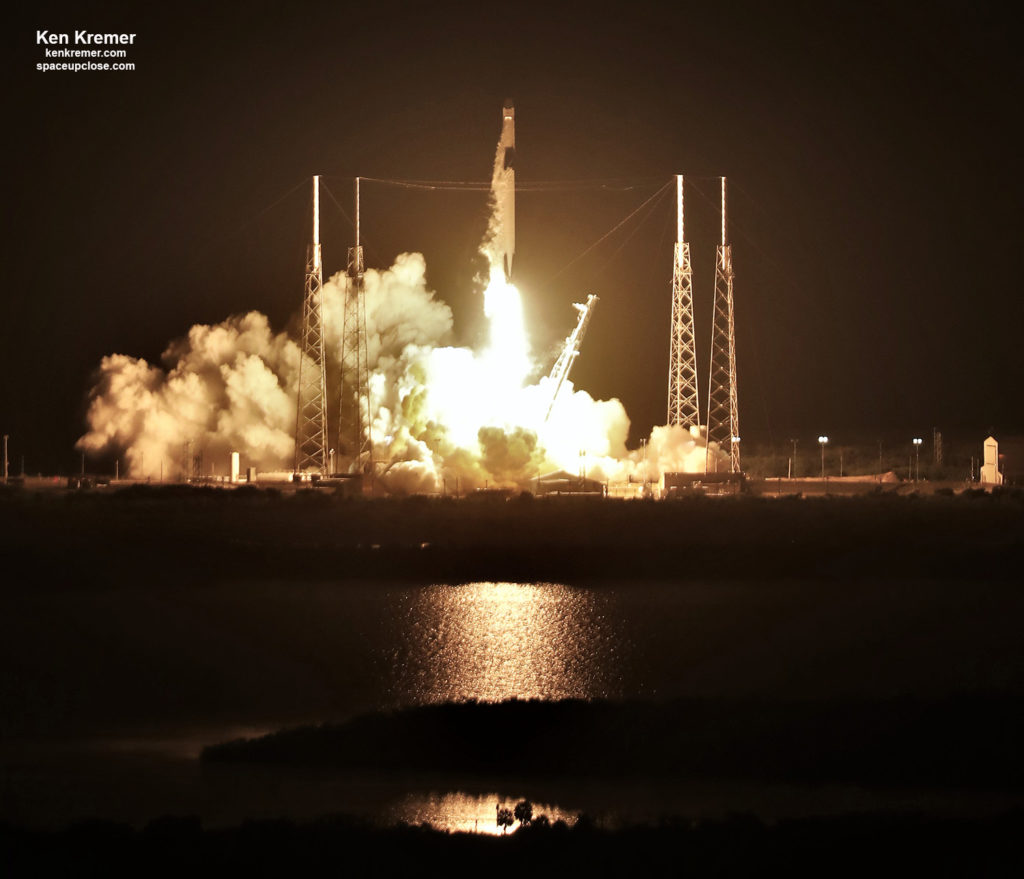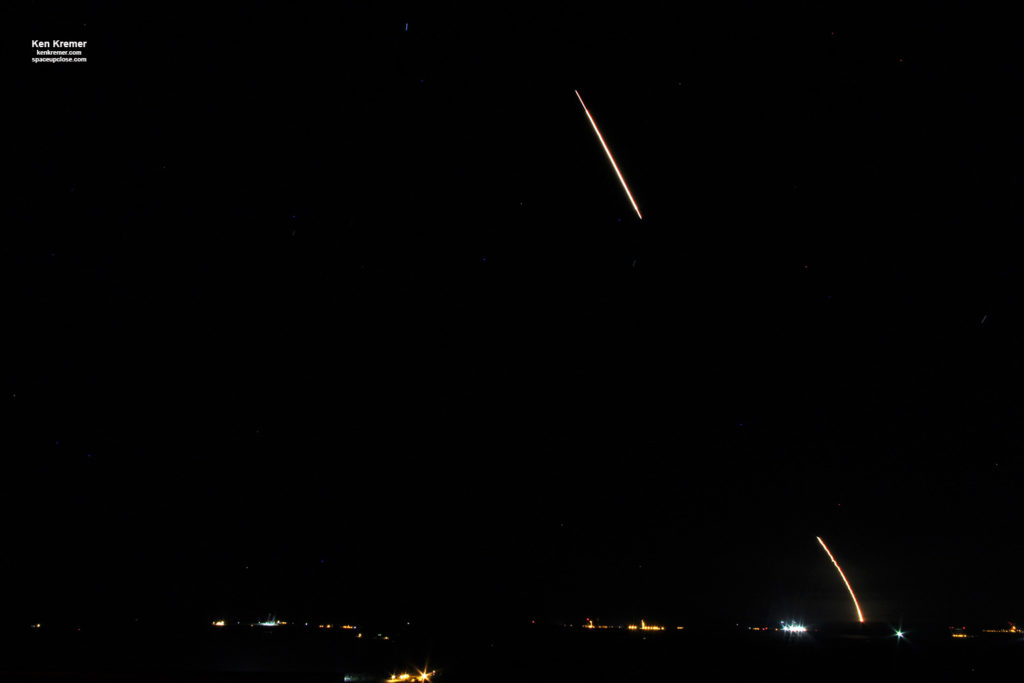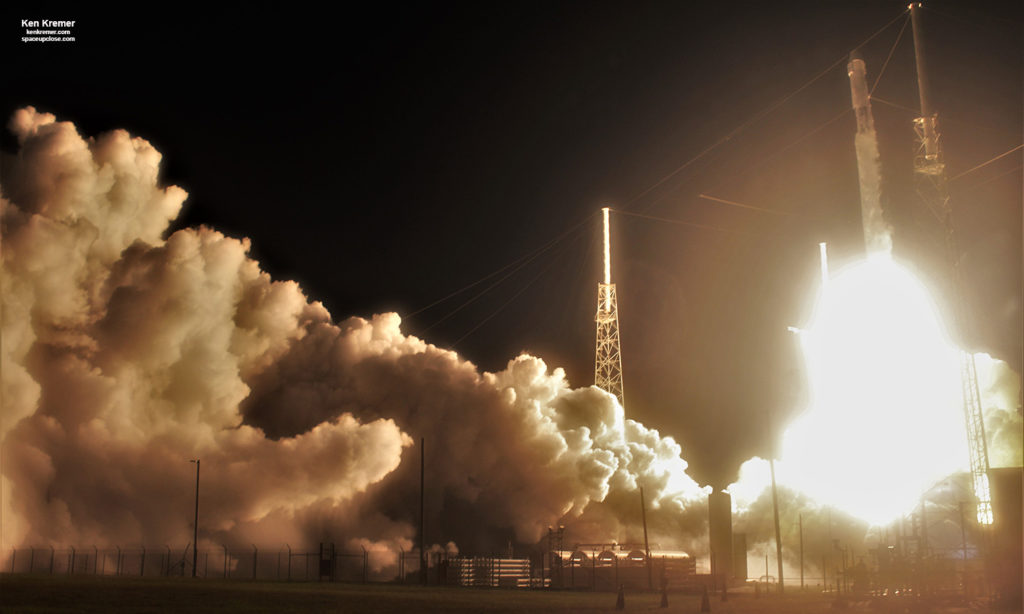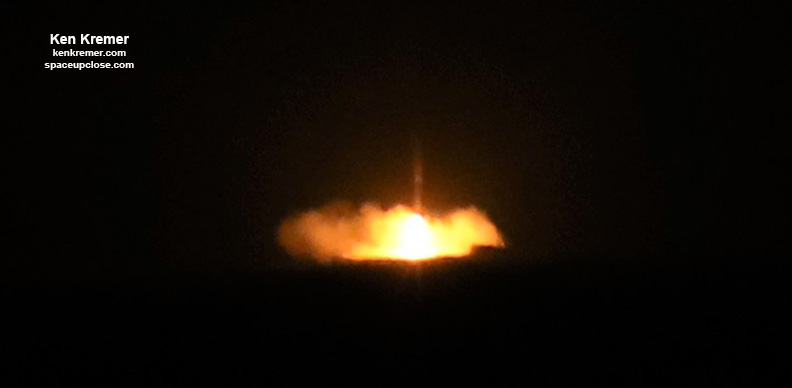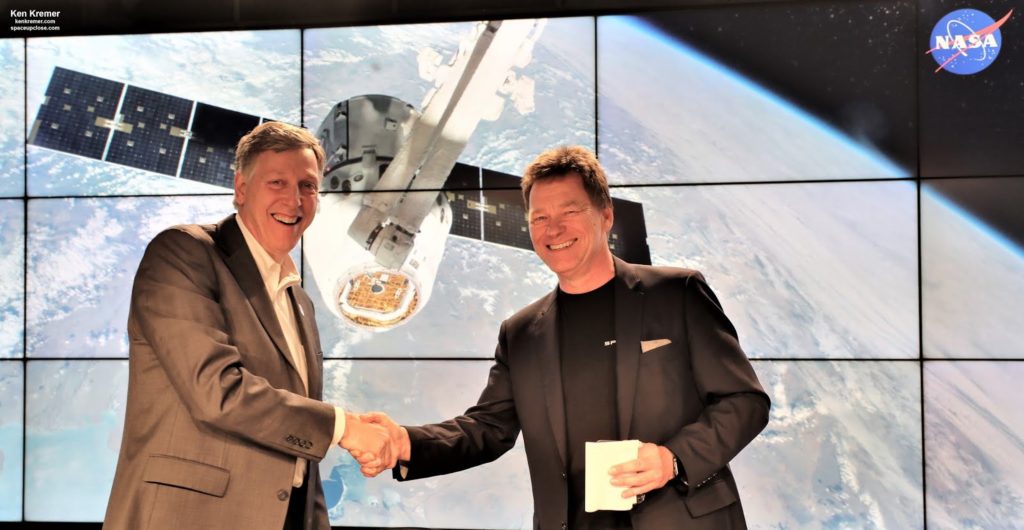Kremer — SpaceUpClose.com &
RocketSTEM – 4 May 2019
KENNEDY SPACE CENTER, FL – The SpaceX team rebounded brilliantly with a simultaneously
stunningly beautiful and technically flawless middle-of the-night launch of a commercial
Falcon 9 rocket carrying a private Dragon resupply craft bound for the International Space Station
with approximately 5,500 pounds of NASA cargo and science investigations
– this morning Friday May 4.
Eight minutes later spectators
witnessed the very exciting and first ever mission featuring a dramatic droneship landing
of the 1st stage booster occurring just a few miles offshore of the
Florida Space Coast beaches – that was easily visible given the crystal clear
night time skies under superbly serene weather conditions.
The SpaceX Falcon 9 successfully blasted off at 2:48 a.m. EDT (0648 GMT) Friday, May 4 with the unpiloted Dragon CRS-17 cargo ship from Space
Launch Complex 40 at Cape Canaveral Air Force Station in Florida bound for the
ISS with almost 3 tons of science investigations and supplies and included research into Earth’s
carbon cycle, numerous biomedical and physical sciences investigations and the
formation of asteroids and comets.
Enjoy our expanding collection
of Space UpClose photos of the magnificent launch and landing.
Check back as the gallery
grows and this story expands. With so many overlapping space events its tough to keep up!
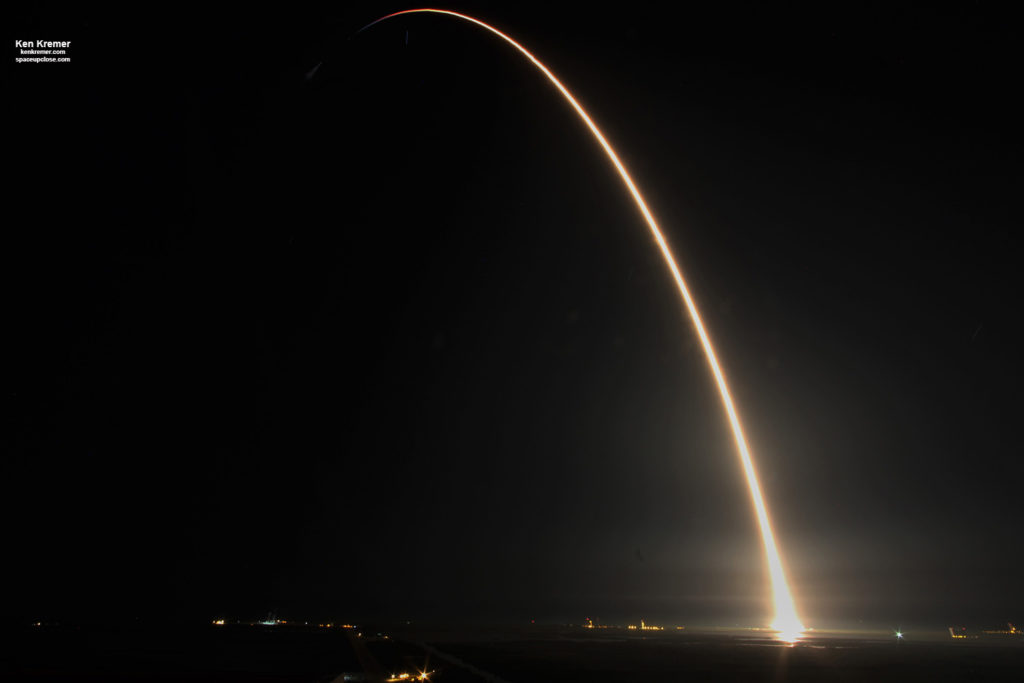 |
|
SpaceX CRS-17 launch
streak after liftoff from Cape Canaveral Air Force Station on May 4, 2019, on its way to the International Space Station – as seen from the VAB roof at NASA’s Kennedy Space Center, FL. Credit: Ken Kremer/kenkremer.com/spaceupclose.com |
The Falcon 9 CRS-17 launch
marked a great comeback for SpaceX following the hugely disappointing and
devastating static fire test malfunction that completely destroyed the Demo-1 Crew
Dragon spacecraft on April 20 just before Easter Sunday – a big setback that
will undoubtedly force a delay in finally launching astronauts aboard the Demo-2
Crew Dragon spacecraft.
CRS-17 is the 17th
SpaceX resupply mission to the ISS.
Those who decided to
forgo watching this action packed launch and landing mission around the 3 a.m.
hour were nonetheless involuntarily awoken anyways by a bunch of house rattling
and knock your socks off sonic booms accompanying the booster touchdown – that
were heard around central Florida as far as 50 minutes away in the Orlando area
people have told me personally.
You could not have asked
for better weather conditions with clear skies over the Cape in every direction.
Liftoff had been delayed
a day after a late in the countdown power failure aboard the ‘Of Course I Still
Love You’ (OCISLY) droneship made it impossible to maintain the ships position for a
successful touchdown.
Booster separation of
the first and second stages likewise was stunning and formed an exquisite nebula
like figure visible high in the night sky for several long seconds.
The droneship power loss
combined with a ground side helium gas leak cause SpaceX engineers to scrub the
launch attempt just before 3 a.m. Thursday May 3 roughly 15 minutes before the
liftoff and recycle 24 hours for Friday’s ultimately successful liftoff.
To everyone surprise the
droneship power loss rather than expected poor weather forced the launch delay.
The booster landing was switched to the OCISLY
droneship positioned just 12 miles offshore from Port Canaveral following the
Crew Dragon destruction – following an emergency approval granted last week
by the Federal Communications Commission (FCC).
The launch had also been delayed several days
after NASA engineers finally fixed an electrical power problem aboard the ISS
that caused by a failed power distribution component Monday morning, May 2, that
had cut power by 25% and curtailed operations at the orbiting lab complex –
including the robotic arm required to grapple and berth the Dragon.
Dragon will join five other spacecraft
currently at the station when it arrive Monday morning May 6.
Coverage of the
spacecraft’s approach and arrival will begin at 5:30 a.m. on NASA Television
and the agency’s website.
From NASA:
Dragon’s launch comes on
the heels of robotics ground controllers in Mission Control Houston successfully completing an
operation to remove a failed Main Bus Switching Unit (MBSU) aboard
the space station and replace it with a spare. The completion of the robotics
work marks the second replacement of an MBSU not involving a spacewalk. The
space station continues to be a critical test bed where NASA is pioneering new
methods to explore space, from complex robotic work to refueling spacecraft in flight and
developing new robotic systems to assist astronauts on the
frontier of space. Technologies such as these will be vital as NASA looks to
return astronauts to the Moon by 2024.
Expedition 59 astronauts
David Saint-Jacques of the Canadian Space Agency and Nick Hague of NASA
will use the space station’s robotic arm to grapple Dragon around 7 a.m.
Coverage of robotic installation to the Earth-facing port of the Harmony module
will begin at 9 a.m.
This delivery, SpaceX’s
17th cargo flight to the space station under NASA’s Commercial Resupply Services
contract, will support dozens of new and existing investigations. NASA’s
research and development work aboard the space station contributes to the
agency’s deep space exploration plans, including returning astronauts to the Moon’s surface in five years.
This Dragon is refurbished and recycled and previously flew
on the prior CRS- 12 mission to the station in Aug 2017.
high, 12-foot-diameter Dragon CRS-16 vessel is jam packed with more than 5500 pounds (2500 kilograms) of science
experiments, research hardware, space parts, food water, clothing and more supplies
for the six person Expedition 59 and 60 crews.
including the two unpressurized cargo payload carried up in the truck and to be
mounted externally: namely NASA’s Orbiting Carbon Observatory-3 (OCO-3) which will measure
levels of carbon dioxide in the atmosphere during its planned 3 year mission and the Space Test Program-Houston 6 (STP-H6).
pounds / 1,517 kilograms
kilograms
kilograms
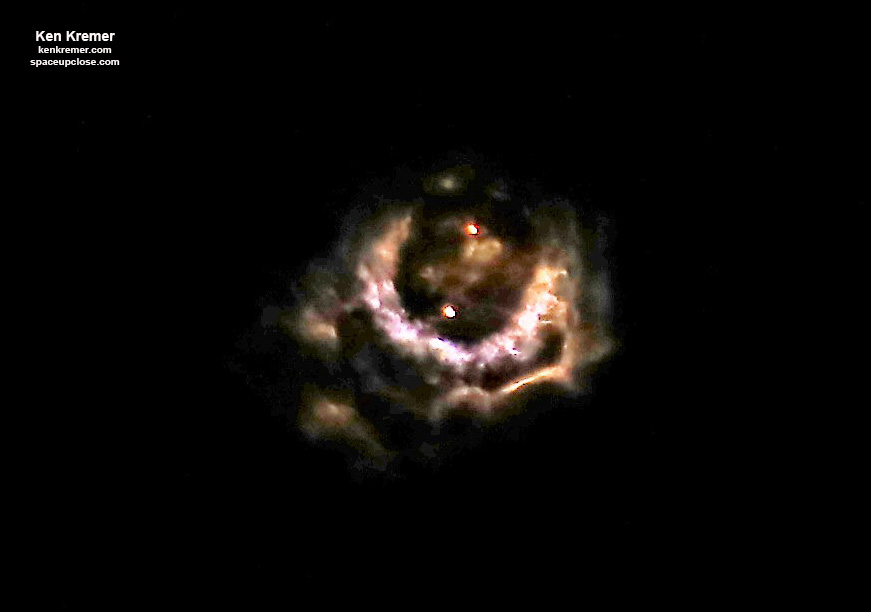 |
|
Credit: Ken Kremer/kenkremer.com/spaceupclose.com
|
scientific investigations Dragon is delivering to the space station:
Atmospheric CO2 from Space
NASA’s Orbiting Carbon Observatory-3 (OCO-3) examines the
complex dynamics of Earth’s atmospheric carbon cycle by collecting measurements
to track variations in a specific type of atmospheric carbon dioxide.
Understanding carbon sources can aid in forecasting increased atmospheric heat
retention and reduce its long-term risks.
Microalgae on the Menu
The Photobioreactor investigation
aims to demonstrate how microalgae can be used together with existing life
support systems on the space station to improve recycling of resources. The
cultivation of microalgae for food, and as part of a life support system to
generate oxygen and consume carbon dioxide, could be helpful in future
long-duration exploration missions, as it could reduce the amount of
consumables required from Earth.
on Chips Advance Human Health Research
Scientists are using a new technology called tissue chips, which could help predict the
effectiveness of potential medicines in humans. Fluid that mimics blood can be
passed through the chip to simulate blood flow, and can include drugs or
toxins. In microgravity, changes occur in human health and human cells that
resemble accelerated aging and disease processes. This investigation allows
scientists to make observations over the course of a few weeks in microgravity
rather than the months it would take in a laboratory on Earth.
Microgravity Experiment Platform
The Hermes facility allows
scientists to study the dusty, fragmented debris covering asteroids and moons,
called regolith. Once installed by astronauts on the space station, scientists
will be able to take over the experiment from Earth to study how regolith
particles behave in response to long-duration exposure to microgravity,
including changes to pressure, temperate and shocks from impacts and other
forces. The investigations will provide insight into the formation and behavior
of asteroids, comets, impact dynamics and planetary evolution.
the hundreds of investigations that
will help us learn how to keep astronauts healthy during long-duration space
travel and demonstrate technologies for future human and robotic exploration
beyond low-Earth orbit to the Moon and Mars. Space station research also provides
opportunities for other U.S. government agencies, private industry, and
academic and research institutions to conduct microgravity research that leads
to new technologies, medical treatments, and products that improve life on
Earth.
completed a critical and successful static hot fire test of their Falcon 9 rocket
first stage engines at 10 a.m. EDT Saturday morning, April 27 for the NASA contracted
resupply mission to the International Space Station (ISS).
exclusive Space UpClose eyewitness photos captured about 13 miles away this
morning in Titusville, Fl – with NASAs iconic and picturesque Vehicle Assembly
Building (VAB) seen nearby in the scene.
and Crew Dragon mission in lead video:
News Orlando about the SpaceX Crew Dragon testing failure here and the implications
for delay in future Crew Dragon test flights here:
onsite coverage of NASA, SpaceX, ULA, Boeing, Lockheed Martin, Northrop Grumman
and more space and mission reports direct from the Kennedy Space Center, Cape
Canaveral Air Force Station, Florida and Wallops Flight Facility, Virginia.
Planetary science and human spaceflight news: www.kenkremer.com –www.spaceupclose.com – twitter @ken_kremer
– email: ken at kenkremer.com
KSC area, active in outreach and interviewed regularly on TV and radio about
space topics.
Ken’s photos are for sale and he is available for lectures and outreach events
Heavy, SpaceX Demo-1 launch/test failure, SpaceX Beresheet launch, NASA missions, ULA Atlas & Delta launches,
Northrop Grumman Antares, SpySats and more at Ken’s upcoming outreach events at
Quality Inn Kennedy Space Center,
Titusville, FL, evenings:
4: “SpaceX Falcon 9 CRS-17
resupply launch to ISS, Demo-1, Beresheet launches, SpaceX Falcon Heavy launches, upcoming SpaceX Falcon 9, ULA, NRO
& USAF Spysats, SLS, Orion, Boeing and SpaceX Commercial crew capsules,
OSIRIS-Rex, InSight Mars lander, Curiosity and Opportunity explore Mars, NH at
Pluto, Ultima Thule and more,” Kennedy Space Center Quality Inn, Titusville,
FL, evenings. Photos for sale


